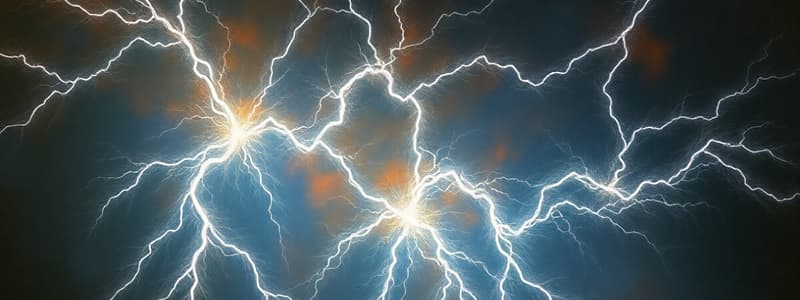Podcast
Questions and Answers
Quel processus de charge implique le contact direct entre un objet chargé et un objet neutre?
Quel processus de charge implique le contact direct entre un objet chargé et un objet neutre?
- Induction
- Radiation
- Conduction (correct)
- Friction
La loi de Coulomb indique que la force électrostatique est attirante quand les charges ont le même signe.
La loi de Coulomb indique que la force électrostatique est attirante quand les charges ont le même signe.
False (B)
Quelle est l'unité de mesure de la force d'un champ électrique?
Quelle est l'unité de mesure de la force d'un champ électrique?
Newtons par Coulomb (N/C)
Lorsque vous frottez un ballon sur vos cheveux, le ballon devient _____ chargé.
Lorsque vous frottez un ballon sur vos cheveux, le ballon devient _____ chargé.
Quel énoncé définit le champ électrique?
Quel énoncé définit le champ électrique?
La loi de Coulomb stipule que la force électrostatique est proportionnelle à la distance entre les charges.
La loi de Coulomb stipule que la force électrostatique est proportionnelle à la distance entre les charges.
Que se passe-t-il lorsqu'un objet chargé est amené proche d'un objet neutre sans contact?
Que se passe-t-il lorsqu'un objet chargé est amené proche d'un objet neutre sans contact?
Associez les processus de chargement à leur description :
Associez les processus de chargement à leur description :
Flashcards
Static Electricity
Static Electricity
An imbalance of electric charges within or on the surface of a material, creating an attractive or repulsive force.
Friction Charging
Friction Charging
Transfer of electrons from one material to another by rubbing them together.
Conduction Charging
Conduction Charging
Transfer of electrons by direct contact between a charged object and a neutral one.
Induction Charging
Induction Charging
Signup and view all the flashcards
Coulomb's Law
Coulomb's Law
Signup and view all the flashcards
Electric Field
Electric Field
Signup and view all the flashcards
Electrostatic Force
Electrostatic Force
Signup and view all the flashcards
Coulomb's constant
Coulomb's constant
Signup and view all the flashcards
Study Notes
Static Electricity
- Static electricity is an imbalance of electric charges within or on the surface of a material.
- This imbalance creates a force that can be observed as attraction or repulsion between objects.
- Static electricity is a buildup of electric charge, not a continuous flow of charge like in an electric current.
- It arises from the transfer of electrons between materials.
Charging Processes
- Friction: Rubbing one material against another can transfer electrons, resulting in one material becoming positively charged and the other negatively charged. For example, rubbing a balloon on hair.
- Conduction: Contact between a charged object and a neutral object can transfer electrons. The neutral object will become charged with the same polarity as the charged object. For example, touching a charged metal rod to a neutral metal sphere.
- Induction: Bringing a charged object close to a neutral object without touching it can induce a separation of charges. The side of the neutral object closest to the charged object will develop the opposite charge. This process causes the object to become temporarily charged without any contact. For example, bringing a negatively charged rod near a neutral electroscope.
Coulomb's Law
- Coulomb's Law describes the electrostatic force between two point charges.
- The force is directly proportional to the product of the magnitudes of the charges.
- The force is inversely proportional to the square of the distance between the charges.
- The force is attractive if the charges have opposite signs; repulsive if the charges have the same sign.
- Mathematically, Coulomb's Law states: F = k * |q1 * q2| / r^2, where
- F is the electrostatic force
- k is Coulomb's constant
- q1 and q2 are the magnitudes of the charges
- r is the distance between the charges.
- Coulomb's Law is a fundamental law in electrostatics.
Electric Fields
- An electric field is a region of space around a charged object where another charged object would experience a force.
- The electric field is a vector field, meaning it has both magnitude and direction.
- The direction of the electric field at a point is the direction of the force that a positive test charge would experience if placed at that point.
- Electric fields originate from positive charges and terminate on negative charges.
- The strength (or intensity) of an electric field is measured in Newtons per Coulomb (N/C).
- The electric field is influenced by the magnitude and distribution of charge.
- Electric field lines are used to visualize the electric field patterns. Lines originate at positive charges, terminate at negative charges, and never cross.
- Electric field strength decreases with distance from the charge.
- A charged particle placed in an electric field experiences a force proportional to the electric field strength and the charge of the particle: F = qE, where
- F is the force on the particle
- q is the charge of the particle
- E is the electric field strength
- The electric field created by multiple charges is the vector sum of the individual electric fields created by each charge.
Studying That Suits You
Use AI to generate personalized quizzes and flashcards to suit your learning preferences.




